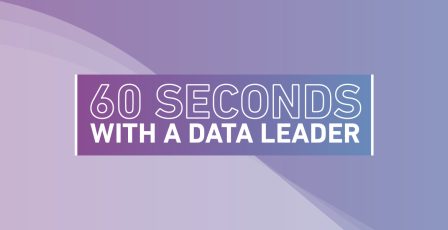Data Catalogue: Cataloguing for Effective Data GovernanceGuiding users to the information they need and empowering businesses to unlock the potential of their data.
Guide
In today’s data-driven world, organisations are swimming in a sea of information and this large quantity can quickly become a burden if the data isn’t properly organised, searchable and trustworthy.
This is where data cataloguing comes in, acting as a beacon that guides users to the information they need and empowering businesses to unlock the true potential of their data.
What is a data catalogue?
A data catalogue is a system or tool used to organise and manage information about data assets. This includes details like data types, format origin, ownership, glossary terms and business definitions.
As well as being a location for this information, it captures vital metadata (data about data) that provides crucial context and understanding.
It acts as a central library for your data and is a fundamental component of data governance, designed to enhance the organisation, accessibility and understanding of data within an enterprise. It plays a critical role in ensuring data across the organisation is well-documented, easily discoverable and securely accessible.
Benefits of data cataloguing
Data cataloguing isn’t just about order – it’s about unlocking the true power of data and there is a wide range of benefits to it.
Enhanced data discovery
Data cataloguing eliminates the frustrations associated with inaccessible data by offering a central location, helping users find the specific data they need, when they need it, along with all the relevant details. This saves time and makes certain users are working with the most accurate and up-to-date information.
Improved data governance
Effective data governance ensures data is accurate, secure and compliant with regulations, avoiding costly and reputation-damaging data breaches. Data catalogues act as a cornerstone for data governance initiatives by providing a clear picture of data ownership (tracking teams and roles).
Increased data literacy
A well-maintained data catalogue can help create a culture of data literacy within an organisation. By centralising information and providing context, data catalogues empower users at all levels to understand and utilise data effectively, encouraging data-driven decision-making.
Streamlined data integration
With diverse data sources and systems, integrating data so it remains consistent across a business can be a complex task. Data catalogues help simplify this process by providing a unified view of the data landscape, allowing for smoother data exchange between systems and promoting data consistency.
Enhanced data quality
Data catalogues serve as a central hub for data quality management. By providing insights into data ownership they identify potential inconsistencies and facilitate data cleansing processes. Ownership feeds nicely into cleansing. If we are aware of a team responsible for certain data, that team can be responsible for the cleanse process. This promotes trust in data-driven decisions.
Aperture Governance Studio allows for comprehensive ownership, including a location where users can search for a person or team, and see a list of data items they are responsible for.
Key takeaway
A data catalogue organises and manages information about data assets, capturing vital metadata so that across the organisation data is easily discoverable and securely accessible.
Data catalogue examples
Data cataloguing isn’t a one-size-fits-all solution, with different industries (and indeed different companies) using data catalogues in different ways; some of these are outlined below.
Finance
Financial institutions leverage data catalogues to track customer data, manage risk profiles and ensure compliance with regulations like KYC (Know Your Customer) and AML (Anti-Money Laundering). Catalogues facilitate data ownership for audit trails and ensure the accuracy of financial data used for critical decisions.
Healthcare
In the healthcare sector, data catalogues play a crucial role in managing patient data securely and ensuring compliance with UK legal frameworks laid out in the Data Protection Act 2018. They help healthcare providers track patient information, medical records and treatment history efficiently, allowing for more informed diagnoses and personalised treatment plans.
Retail
Retailers use data catalogues to manage customer data and develop a single customer view, analyse purchasing trends and optimise marketing campaigns. By providing insights into customer behaviour and preferences, data catalogues help retailers personalise the shopping experience and drive sales.
Manufacturing
Manufacturers leverage data catalogues to track production data, monitor equipment performance and optimise supply chains. Data lineage helps identify bottlenecks and potential quality issues, facilitating more informed decision-making when it comes to boosting the efficiency of production processes.
Essential components for a robust data catalogue
A successful data catalogue requires careful planning and implementation. Here are some key components to consider.
Data discovery and inventory
The first step involves the creation of an inventory of business data assets across the organisation; this process involves collecting/discovering data from various sources such as databases, data lakes, legacy systems and cloud storage. The goal is to gain a comprehensive understanding of the available information.
Metadata catalogue
Metadata management is crucial for understanding your data and focuses on capturing, storing and managing data about data. This includes technical metadata (data types, formats, origin) and business metadata (data ownership, glossary, business context). Effective metadata management facilitates better understanding and utilisation of data assets.
Data catalogue taxonomy, classification and categorisation
Data catalogues have to be organised and structured in a way that makes sense for your business or organisation. Data taxonomy serves as a way to organise data into categories and subcategories based on various criteria such as:
- Sensitivity
- Department
- Business function
- Data type
- Source
- Usage
- Ownership
This structured classification not only enhances data management and compliance with regulatory requirements but also supports data quality, discoverability, accessibility and understanding. A clear data catalogue system helps with good data governance and ensures stakeholders can easily find and interpret the data they require. It tracks data assets, promotes data-driven decision-making and makes data integration and compatibility easier.
Data classification helps in applying appropriate governance policies, such as access controls and data protection measures. This ensures that only the correct people or groups have access to the information when it’s needed.
Data quality management
Ensuring the accuracy, completeness and reliability of the data catalogued is essential. Data quality management includes the establishment of quality metrics, monitoring data quality, identifying data issues such as inconsistencies and missing values, as well as implementing processes for cleansing and validating data.
Data quality is also important for version control – as catalogues can track different versions of data assets, it’s important to ensure all users are only working with the most up-to-date information. This not only helps identify potential quality issues but also facilitates data profiling for better understanding.
Data access and security
As data security is paramount, data access focuses on setting up policies and mechanisms for secure access to data. It involves managing permissions based on user roles, logging and tracking data access and usage patterns and implementing access controls to minimise unauthorised access and data breaches. It also ensures that data is accessed in compliance with organisational policies and data protection regulations such as GDPR (General Data Protection Regulation).

Data flow and provenance
Understanding the source, history and lifecycle of data is crucial. Businesses that can track where data comes from and how it moves through their estate can use this information to support regulatory compliance, leveraging it to drive data accountability, data auditability and data quality management from source to archive.
Managing and monitoring data flow also helps organisations identify which downstream systems rely on specific data sets – facilitating impact analysis when changes are made to data.
Search and discovery tools
Implementing tools that enable users to easily search for and discover data assets within the catalogue is essential for data discoverability. This includes the development of user-friendly interfaces, keyword searches, advanced search algorithms and filters to facilitate efficient data discovery based on the categories and subcategories within the data taxonomy.
Integration and interoperability
The data cataloguing system needs to be able to integrate with other data management and IT systems such as data lakes and warehouses. It’s important to ensure different types of data and tools work well together for smooth data flow and processes.
Compliance and regulatory adherence
Data, and the management of data, need to comply with relevant data protection laws, industry regulations and internal policies. This involves implementing mechanisms to monitor compliance and adapt to changing regulatory requirements.
Data catalogues can assist with compliance by:
- Mapping data elements with specific compliance requirements
- Maintaining logs of data access and usage for audit purposes
- Automating data retention policies to ensure compliance with regulations regarding data storage and deletion.
Stakeholder engagement and collaboration
It’s important to ensure the data catalogue meets the needs of different departments, teams and roles. Look to engage with various stakeholders across the organisation by ensuring adequate training on how to navigate and utilise catalogues efficiently, support for questions and specific use cases and collaboration to promote a culture of data governance and literacy.
To help ensure successful engagement and collaboration, identify data champions from different departments and at different levels who will work to promote the use of the data catalogue and encourage user adoption.
Monitoring, reporting and continuous improvement
Once a data catalogue is up and running, this is not the end of the process. Establishing metrics and dashboards to monitor the effectiveness of data cataloguing efforts is vital for maintaining an effective data catalogue. This includes reporting on key performance indicators and identifying opportunities for continuous improvement in data governance practices.
There’s also the element of maintaining the catalogue as more data is generated and existing data moves through the data lifecycle.
There are many methods to monitor and report on the effectiveness of a data catalogue, including:
- Tracking user activity to analyse user search patterns and identify areas for improvement; for example, if users never go beyond a certain point of the catalogue, perhaps there is a way to improve the user journey so that they do
- Monitor data quality metrics to make sure the data in the catalogue is accurate and reliable, ensuring that data-driven decisions are only made on the most up-to-date information
- Conduct regular reviews of the data catalogue’s helpfulness, allowing for areas of improvement to be identified and updated based on new data governance practices.
Cloud data catalogue
Cloud technology has shifted how many businesses handle their data assets, with cloud-based platforms providing data management tools across various online-accessible cloud services. Cloud-based data technology offers a scalable and cost-effective solution for data catalogue management.
Cloud-based data catalogues offer several benefits:
Scalability
Cloud-based data catalogues can easily scale to accommodate growing data volumes and user needs, eliminating the need for expensive hardware upgrades associated with on-premise data catalogue solutions.
Real-time updates
Cloud data catalogues can provide real-time updates on data changes and metadata modifications, ensuring users always have access to the most up-to-date information.
Maintain consistency
With cloud data cataloguing, it’s easier than ever to maintain consistency with real-time changes to taxonomy and metadata.
Accessibility
Cloud-based data catalogues can be accessed from anywhere with an internet connection, fostering collaboration and data sharing across geographically dispersed teams.
Cost-effectiveness
Cloud data catalogues often operate on a pay-as-you-go model, eliminating upfront infrastructure costs and reducing IT maintenance expenses.
Integration with cloud-based data management tools
Cloud data catalogues integrate seamlessly with other cloud-based data management tools and platforms, streamlining data workflows and fostering a unified data ecosystem.
Data cataloguing best practices
Organisations can create a strong system for organising data by focusing on the key elements of data cataloguing. As well as the key elements, it’s also important to keep in mind the following best practices to ensure data is correct, easy to access and safe, leading to organisations getting the most value from their data.
Define clear objectives and scope
Start by outlining the specific goals and objectives you want to achieve with data cataloguing. Is the aim to improve data discovery, enhance data governance or comply with regulations? Clearly define the scope of data assets that will be included in the catalogue.
Identify stakeholders and engage early
Data cataloguing is a collaborative effort across an organisation. Identify key stakeholders across different departments (for example IT, Data Analysts and Business Users) who will use and benefit from the catalogue. Involve them early on to gather requirements and ensure the catalogue meets their needs, as well as the needs of the organisation as it’s important to balance the two.
Establish a data governance framework
Data cataloguing thrives under a well-defined data governance framework. This framework outlines policies and procedures for data management, access control and data quality. The data catalogue should align with these established data governance principles.
Metadata governance is a crucial component of data governance due to its importance in adding the structure and function of the data. It focuses on the management and control of metadata and includes developing an effective plan that covers various aspects of metadata management. This plan can include defining consistent standards for effective data discovery and understanding as well as collecting and analysing data so it can be captured, stored and maintained effectively.
Prioritise data quality
It is of paramount importance that data collected and held is of good quality – look to integrate data quality management strategies into your data cataloguing process from the beginning to ensure data quality. Also, introduce policies and procedures to identify and address data quality issues like inconsistencies, missing values and duplicate entries before populating the catalogue.
Automate data collection (where possible)
Manually populating a data catalogue can be time-consuming and can cause issues within the data caused by human error. By leveraging automation tools, it will be easier and less time-consuming to discover data assets from various sources and automate metadata capture whenever possible. This will also help maintain data quality as automating data collection will reduce potential human errors.
Focus on the users
There are many ways to focus on the data catalogue users such as ensuring the data catalogue should be user-friendly and intuitive. When designing the catalogue, prioritise ease of navigation, clear search functionalities and relevant data visualisation to encourage user adoption. This is also important for promoting a data-literate workforce, as for users to be able to understand, trust and leverage the data effectively, they need to be able to navigate the data catalogue with confidence.
Another way to focus on the user is to provide them with comprehensive training on how to navigate and utilise the data catalogue effectively; and offer ongoing support to address any challenges or questions users may encounter.
Key takeaway
- With the volume of data generated by and available to modern business ever increasing, a data catalogue is a critical tool in organising, indexing and understanding a data estate.
- A catalogue is foundation for data governance as it provides a clear picture of the data estate.
- A catalogue promotes data literacy and collaboration by delivering understanding of data to business users.
How can we help?
If you’re ready to begin your data governance journey, Aperture Governance Studio is our flexible, outcome driven solution for clients looking for an intuitive data quality and governance platform. We take the complexity out of data management with a simple, intuitive solution that is fast to deploy and offers rapid time to value, helping clients to better understand and control their data.
If you want to get started with data governance but need some support, we have a wealth of experience and our data governance subject matter experts are on hand to support and guide you in line with your bespoke business requirements. Email us now.
About Aperture Governance Studio
Our data governance solution brings clarity, trust and understanding to your data estate in days.
Find out more










